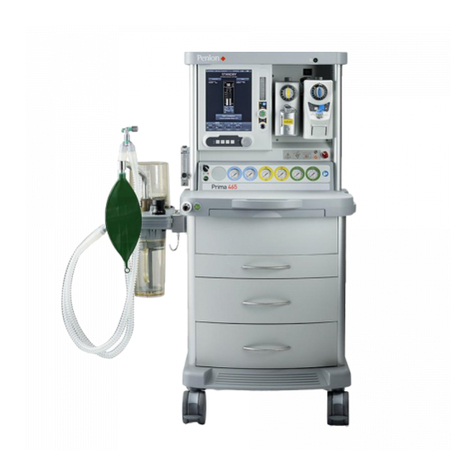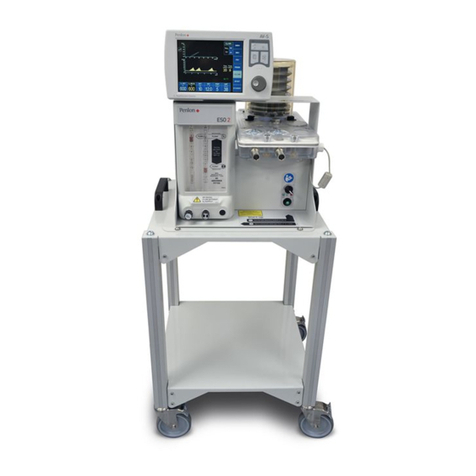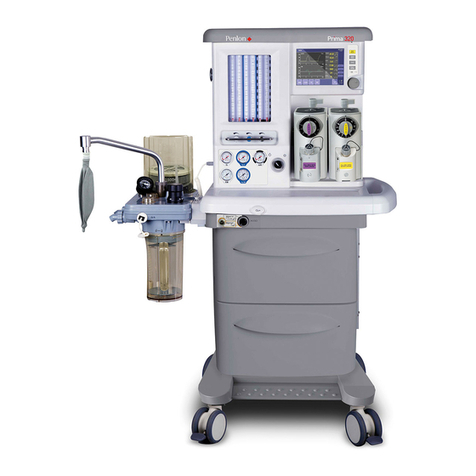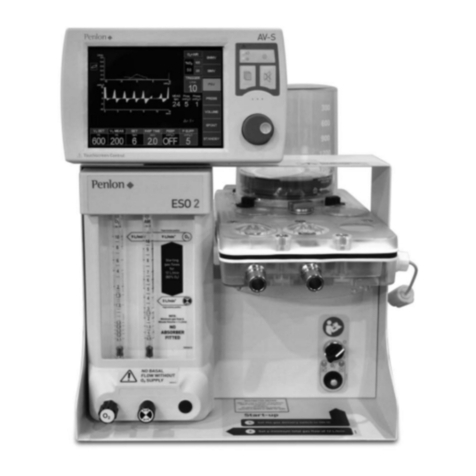
A200SP Absorber 2 User Manual
1. Warnings and Cautions
The followng WARNINS and AUTIONS must be read and
understood before usng ths Anaesthetc Apparatus
WARNINS
1 Personnel must make themselves famlar wth the
contents of ths manual and the functon of the A200SP
Absorber before use
2 Trchloroethylene must not be used n assocaton wth
soda lme
3 Ths unt s restrcted to use wth non-flammable
anaesthetc agents only
4 The A200SP Absorber must only be used when securely
mounted n an uprght poston
a) The nspratory and expratory non-return valves
(NRV) are gravty operated See secton 32
b) Spllage of absorbent may contamnate the breathng
system See secton 51
5 To avod the rsk of electrc shock, ths equpment must
only be connected to a mans supply wth a protectve
earth
6 To solate the machne from the mans power supply,
dsconnect the mans cable from the mans power outlet
Always use an easly accessble mans power outlet
7 Ths devce must not be altered or modfed n any way
wthout the wrtten approval of Penlon Lmted
Before usng the absorber
8 Breathng system connecton Do not use a patent
Y-pece contanng non-return valves Usage wth the
Absorber s hazardous, because two sets of non-return
valves may easly be connected n opposton, by error
See secton 52
9 Breathng hoses and bags used wth the absorber must
comply to BS EN ISO 5367 (Hoses) and BS EN ISO 5362
(Breathng Bags) respectvely
10 Do not connect a vacuum systems must not drectly to
the adustable pressure lmtng (APL) valve outlet A
recevng system wth postve and negatve pressure
control functons must be nterposed Systems must
comply wth EN ISO 8835 Part 2 or BS EN ISO 80601-2-
13 See secton 523
11 The APL valve s out of crcut when the system s n
‘Ventlator’ mode The ventlator must be equpped wth a
pressure relef valve
12 Underfllng of the canster can lead to neffcent O
absorpton Overfllng may result n poor sealng of
canster due to cakng of granules and abrason of the
canster and seal See secton 532
13 Anhydrous soda lme s known to react wth some
anaesthetc agents Do not contnue to use an absorbent
f t has been allowed to dry out (or f you suspect t has
dred out) Always replace dred-out absorbent wth a
fresh supply of soda lme
14 Do not use the absorber wthout ensurng that t passes
all pre-use checks See secton 6After servcng and
cleanng procedures, verfy postve acton of the bag/
ventlator selector swtch before the unt s used
clncally
heck that at all tmes that the swtch s free to move
from one end of ts travel to the other
Usng the absorber
15 ondensaton, whch may collect n the bottom of the
absorber canster s caustc and care must be taken not
to spll t on the skn when dranng See secton 73
16 Knkng of the fresh gas hose s a known cause of
anaesthetc accdent The use of an unsutable hose
assembly can contrbute to ths stuaton
See secton 35
17 Any system utlsng the A200SP absorber must be ftted
wth
a) An oxygen montor complyng wth ISO/IE 80601-2-
55
b) A carbon doxde montor complyng wth ISO/IE
80601-2-55
c) A mnute volume montor
d) A breathng system ntegrty alarm
18 Refttng the canster
The canster seals at the top face Mantan the poston
of the rm of the canster over the outer lp of the seal as
you rotate the lever ant-clockwse to the vertcal, locked-
on poston
Falure to lock the canster n the fully closed poston,
may cause a system leak and/or a reducton n O
absorpton
19 Heater unt (f ftted)
Exteror panels must not be removed by unauthorsed
personnel, and the unt must not be operated wth such
panels mssng
There s a possble electrc shock hazard
20 Portable RF communcatons equpment (ncludng
perpherals such as antenna cables and external
antennas) should be used no closer than 30 cm (12
nches) to any part of ths devce, ncludng cables
specfed by the manufacturer Otherwse, degradaton of
the performance of ths equpment could result
21 You must only use non-conductve breathng system
hoses Breathng hoses must not have electrcally
conductve propertes
22 Ths machne s not sutable for use n oxygen-rch
envronment
23 Do not touch any electrcal devce connector at the same
tme as the patent































